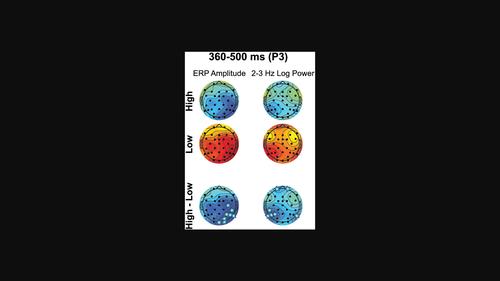当前位置:
X-MOL 学术
›
Eur. J. Neurosci.
›
论文详情
Our official English website, www.x-mol.net, welcomes your
feedback! (Note: you will need to create a separate account there.)
To see, not to see or to see poorly: Perceptual quality and guess rate as a function of electroencephalography (EEG) brain activity in an orientation perception task
European Journal of Neuroscience ( IF 2.7 ) Pub Date : 2021-09-06 , DOI: 10.1111/ejn.15445 Sarah S. Sheldon 1 , Kyle E. Mathewson 1, 2
European Journal of Neuroscience ( IF 2.7 ) Pub Date : 2021-09-06 , DOI: 10.1111/ejn.15445 Sarah S. Sheldon 1 , Kyle E. Mathewson 1, 2
Affiliation

|
Detection of visual stimuli fluctuates over time, and these fluctuations have been shown to correlate with time domain evoked activity and frequency-domain periodic activity. However, it is unclear if these fluctuations are related to a change in guess rate, perceptual quality or both. Here we determined whether the quality of perception randomly varies across trials or is fixed so that the variability is the same. Then we estimated how perceptual quality and guess rate on an orientation perception task relate to electroencephalography (EEG) activity. Response errors were fitted to variable precision models and the standard mixture model to determine whether perceptual quality is from a varying or fixed distribution. Overall, the best fit was the standard mixture model that assumes that response variability can be defined by a fixed distribution. The power and phase of 2–7 Hz post-target activities were found to vary along with task performance in that more accurate trials had greater power, and the preferred phase differed significantly between accurate and guess trials. Guess rate and σ were significantly lower on trials with high 2- to 3-Hz power than low, and the difference started around 250-ms post-target. These effects coincide with changes in the P3 event-related potential (ERP): There was a more positive deflection in the accurate trials versus guesses. These results suggest that the spread of errors (perceptual quality) can be characterised by a fixed range of values. Where the errors fall within that range is modulated by the post-target power in the lower-frequency bands and their analogous ERPs.
中文翻译:

看,看不到或看得很差:感知质量和猜测率作为脑电图 (EEG) 大脑活动在定向感知任务中的函数
视觉刺激的检测随着时间的推移而波动,并且这些波动已被证明与时域诱发活动和频域周期性活动相关。然而,尚不清楚这些波动是否与猜测率、感知质量或两者的变化有关。在这里,我们确定了感知质量是否在试验中随机变化,或者是固定的,因此可变性是相同的。然后我们估计了方向感知任务的感知质量和猜测率与脑电图 (EEG) 活动的关系。将响应误差拟合到可变精度模型和标准混合模型,以确定感知质量是来自变化分布还是固定分布。总体而言,最佳拟合是标准混合模型,该模型假定响应可变性可以由固定分布定义。发现 2-7 Hz 目标后活动的功率和相位随着任务性能的不同而变化,因为更准确的试验具有更大的功率,并且在准确和猜测试验之间首选相位有显着差异。在 2 到 3 赫兹的高功率试验中,猜测率和 σ 显着低于低功率试验,并且差异在目标后 250 毫秒左右开始。这些影响与 P3 事件相关电位 (ERP) 的变化相吻合:准确试验与猜测相比,存在更积极的偏差。这些结果表明,错误的传播(感知质量)可以通过固定范围的值来表征。在该范围内的误差由较低频带中的目标后功率及其类似的 ERP 调制。
更新日期:2021-09-06
中文翻译:

看,看不到或看得很差:感知质量和猜测率作为脑电图 (EEG) 大脑活动在定向感知任务中的函数
视觉刺激的检测随着时间的推移而波动,并且这些波动已被证明与时域诱发活动和频域周期性活动相关。然而,尚不清楚这些波动是否与猜测率、感知质量或两者的变化有关。在这里,我们确定了感知质量是否在试验中随机变化,或者是固定的,因此可变性是相同的。然后我们估计了方向感知任务的感知质量和猜测率与脑电图 (EEG) 活动的关系。将响应误差拟合到可变精度模型和标准混合模型,以确定感知质量是来自变化分布还是固定分布。总体而言,最佳拟合是标准混合模型,该模型假定响应可变性可以由固定分布定义。发现 2-7 Hz 目标后活动的功率和相位随着任务性能的不同而变化,因为更准确的试验具有更大的功率,并且在准确和猜测试验之间首选相位有显着差异。在 2 到 3 赫兹的高功率试验中,猜测率和 σ 显着低于低功率试验,并且差异在目标后 250 毫秒左右开始。这些影响与 P3 事件相关电位 (ERP) 的变化相吻合:准确试验与猜测相比,存在更积极的偏差。这些结果表明,错误的传播(感知质量)可以通过固定范围的值来表征。在该范围内的误差由较低频带中的目标后功率及其类似的 ERP 调制。











































 京公网安备 11010802027423号
京公网安备 11010802027423号